Effectiveness of Options for the Adaptation of Crop Farming to Climate Change in a Country of the European South
Abstract
1. Introduction
2. Materials and Methods
2.1. Study Area
2.2. Climate Simulations
2.3. Methodology for the Assessment of Adaptation Options
- For most annual crops (e.g., cereals, rice, cotton, vegetables), we used the Decision Support System for Agrotechnology Transfer (DSSAT, Ver 4.8.0.027, DSSAT Foundation, Gainesville, FL, USA) [40] to simulate adaptation options. DSSAT includes many crop growth simulation (agronomic) models; in the context of our previous work mentioned above, we adjusted those models to Greek conditions as much as possible and calibrated them using regional historical data on crop yields. The models’ calibration process is described in detail in the relevant paper [37]. The accuracy of these calibrated models, which were used in our present study to assess the different adaptation options, is considered satisfactory as the deviations between the observed crop yields of the 2011–2019 period and those simulated by the calibrated DSSAT models for the 20-year historical climate reference period do not exceed ±15% across all crops-regions and are even below the ±10% level in almost all of them. In the present study, we used these calibrated models without any changes under the historical climate reference period and the ‘No adaptation’ case. To assess specific adaptation measures, we appropriately modified their input data on planting dates, irrigation management schemes, and hybrids/cultivars to reflect the changes to be introduced by these measures (Section 2.3.1).
- For vineyards, we assessed adaptation options by using the Agricultural Production Systems Simulator software tool (APSIM, Ver. 7.10, APSIM initiative, Queensland, Australia) [41,42]. In the context of our previous research, we calibrated the grape growth model of APSIM for a high-value-added foreign variety widely cultivated in Greece (i.e., Sauvignon Blanc) and for representative wine-producing locations in the northern and southern regions of the country. The model’s calibration process is described in detail in the relevant paper [37]. The accuracy of the calibrated model, which was used in our present study to assess the different adaptation options, is considered satisfactory as the deviations between the observed average crop yields during 2011–2019 and those simulated by the calibrated APSIM model do not exceed ±8% across grape and wine producing regions in northern and southern Greece. In the present study, the model’s simulations under the historical climate reference period and the ‘No adaptation’ case remained unchanged. Again, we appropriately modified the model’s input data on crop management practices and cultivar characteristics to assess adaptation options (Section 2.3.1).
- For crops that are not yet covered by the DSSAT crop growth models (mainly perennial and arboreal crops), in the context of our previous work, we developed statistical regression models (based on regional historical data on crop production, cultivated areas, and climatic conditions) for all major crops cultivated in various Greek regions, linking crop yields and climatic parameters at the regional level. The accuracy of these models is satisfactory as most (77%) of them have an R2 value equal to or greater than 0.7, and all of them have a significance F value less than 0.05 (with most having a significance F value less than 0.001). More details are provided in the relevant paper [37]. In the present study, we utilized these statistical regression models without any changes under the historical climate reference period and the ‘No adaptation’ case, and we modified their inputs on precipitation to assess the effectiveness of increased/added irrigation (Section 2.3.2).
2.3.1. Simulation of Adaptation Options Using Agronomic Models
- (a)
- For earlier planting, the sowing dates of the various crops in the DSSAT simulation files were shifted one month earlier, complemented where necessary by changes in the scheduling (but not in the total annual quantity) of irrigation/fertilization. Given the large number of crops and regions, the two future periods, and the three climate change scenarios, and to reduce computational effort, we applied a one-month shift to all regions and crops. For each crop, shifting its sowing date alters its growth cycle due to changes in climatic conditions compared to the ‘No adaptation’ case, and hence, has the potential to affect the maturity date and crop yield at maturity. For example, for crops where maturity in the absence of adaptation typically occurs in summer, an earlier planting can reduce exposure to adverse summer conditions (e.g., extreme heat, drought) and consequently limit the adverse effects on yields.
- (b)
- For crops already irrigated under the ‘No adaptation’ case, we modified appropriately the DSSAT simulation files to include a 15–20% increase in irrigation volume. This percentage increase was applied uniformly to the existing irrigation scheduling except in cases where early simulation results revealed that a more time-targeted increase in irrigation was necessary for the adaptation measure to lead to an improvement over ‘No adaptation’. For crops grown mostly in drylands in Greece, such as barley, wheat, and a small portion of cotton, irrigation was added to the DSSAT simulation files, with an irrigation schedule based on the relevant one for irrigated crops. An increase/addition of irrigation can significantly improve crop yields by providing consistent moisture levels to crops that are fundamental for plant growth.
- (c)
- The effects on crop yields from introducing hybrids/cultivars resilient to climate change are challenging to simulate, as data on their physiological behavior are rarely available in the literature. Thus, we decided to focus on two crops, barley and maize, for which there is already significant progress in developing new hybrids/cultivars that are more tolerant to climate change, and which are of particular importance in Greece. Of special importance are hybrids/cultivars with a short biological cycle, which have the advantage of completing their development before the very hot and dry summer days (which will be even hotter and drier in the future). Thus, through a trial-and-error process, the DSSAT input files were modified so that the crop cycle resulting under this adaptation option is shorter than the one under ‘No adaptation’.
2.3.2. Assessment of Adaptation Options Using Statistical Models
3. Results
3.1. Effectiveness of Earlier Planting
3.2. Effectiveness of Increase/Addition of Irrigation
3.2.1. Crops Simulated by Statistical Regression Models
3.2.2. Crops Simulated by the DSSAT and the APSIM Tools
3.3. Effectiveness of More Resilient Hybrids/Cultivars
3.4. Overall Picture of the Effectiveness of Adaptation Measures
4. Discussion
- (a)
- Regarding annual crops, our quantitative assessment of the effects of adaptation options on crop yields mainly relied on crop simulations through the DSSAT tool, carried out for each of the 13 Greek administrative regions, five climate simulations, three RCP scenarios, two 20-year periods, several cultivars for each crop, and many agricultural soil types. In addition, those simulations were first performed yearly (i.e., the model estimated crop growth per day of each year, from sowing to harvest); then, the calculated crop yields were averaged per period and RCP scenario. This modeling process, although it allows for a very detailed simulation of crops’ growth under specific management and climatic conditions, requires a significant numerical effort, particularly for the adaptation option of irrigation, which was examined for all crops simulated through the DSSAT (11 crops in total) and all Greek regions. To reduce computational time, we applied specific software programming scripts that allowed us to automate, to some extent, the utilization of input data and the processing of output data, thus significantly reducing the computational time. However, the number of simulations needed for irrigation remained high; therefore, we limited the assessment of this adaptation measure for the 2041–2060 period to the RCP8.5 scenario, the most extreme climate change projection. Consequently, our assessment of the effectiveness of irrigation as an adaptation option in this second 20-year period represents a conservative estimate. Additional climate change scenarios should be examined in future research, particularly for crops and regions where the measure’s effectiveness drops significantly from 2021–2040 to 2041–2060.
- (b)
- The significant computational effort due to the several crops, regions, climate simulations, RCP scenarios, hybrids/cultivars, and types of agricultural soils considered during simulations carried out by agronomic models limited the elaboration of sensitivity analyses regarding the amount and schedule of the additional irrigation water, the shifting of planting dates by less or more than one month and in a non-uniform manner for all crops, and the assessment of several short-cycle hybrids/cultivars. We performed such analyses for irrigation applied to the crops simulated by statistical regression models and only to a small extent for crops simulated by the DSSAT and APSIM tools. Further sensitivity analyses regarding irrigation, shift of planting dates, and other crop management practices represent another area for future research, particularly for regions with significant climate variability and/or already limited water resources and crops showing significant crop yield reductions under no adaptation.
- (c)
- Although statistical regression models allowed us to assess the effects of additional irrigation on the regional yields of several crops not yet covered by the specific agronomic models used in this study, the form and content of the equations of these models prevented the examination of the other two adaptation options, namely shifting planting dates and using short-cycle hybrids/cultivars. Thus, in the context of future research, agronomic models for crop growth simulations that would allow the assessment of additional adaptation options should be developed, particularly for tree cultivations with a high added value in Greece, such as olive trees and citrus fruit trees.
5. Conclusions
Supplementary Materials
Author Contributions
Funding
Institutional Review Board Statement
Data Availability Statement
Acknowledgments
Conflicts of Interest
References
- Arora, P. COP28: Ambitions, realities, and future. Environ. Sustain. 2024, 7, 107–113. [Google Scholar] [CrossRef]
- COP28-United Nations Climate Change. Available online: https://www.cop28.com/en/food-and-agriculture (accessed on 27 August 2024).
- European Environment Agency. Climate Change Adaptation in the Agriculture Sector in Europe; Publications Office of the European Union: Luxembourg, 2019; pp. 24–35. Available online: https://www.eea.europa.eu/publications/cc-adaptation-agriculture/ (accessed on 10 August 2024).
- United Nations. A/RES/70/1-Transforming Our World: The 2030 Agenda for Sustainable Development; United Nations: New York, NY, USA, 2015; Available online: https://sdgs.un.org/2030agenda (accessed on 27 August 2024).
- Food and Agriculture Organization (FAO) of the United Nations. Transforming Food and Agriculture to Achieve the SDGs-20 Interconnected Actions to Guide Decision-Makers; Food and Agriculture Organization of the United Nations: Rome, Italy, 2018; Available online: http://www.fao.org/3/I9900EN/i9900en.pdf (accessed on 27 August 2024).
- Bednar-Friedl, B.; Biesbroek, R.; Schmidt, D.N.; Alexander, P.; Børsheim, K.Y.; Carnicer, J.; Georgopoulou, E.; Haasnoot, M.; Le Cozzanet, G.; Lionello, P.; et al. Chapter 13: Europe. In Climate Change 2022: Impacts, Adaptation and Vulnerability. Contribution of Working Group II to the Sixth Assessment Report of the Intergovernmental Panel on Climate Change; Pörtner, H.-O., Roberts, D.C., Tignor, M., Poloczanska, E.S., Mintenbeck, K., Alegría, A., Craig, M., Langsdorf, S., Löschke, S., Möller, V., et al., Eds.; Cambridge University Press: Cambridge, UK; New York, NY, USA, 2022; pp. 1817–1927. [Google Scholar] [CrossRef]
- Ali, E.; Cramer, W.; Carnicer, J.; Georgopoulou, E.; Hilmi, N.J.M.; Le Cozannet, G.; Lionello, P. Cross-Chapter Paper 4: Med-iterranean Region. In Climate Change 2022: Impacts, Adaptation and Vulnerability. Contribution of Working Group II to the Sixth Assessment Report of the Intergovernmental Panel on Climate Change; Pörtner, H.-O., Roberts, D.C., Tignor, M., Poloczanska, E.S., Mintenbeck, K., Alegría, A., Craig, M., Langsdorf, S., Löschke, S., Möller, V., et al., Eds.; Cambridge University Press: Cambridge, UK; New York, NY, USA, 2022; pp. 2233–2272. [Google Scholar] [CrossRef]
- Haro-Monteagudo, D.; Palazón, L.; Zoumides, C.; Beguería, S. Optimal Implementation of Climate Change Adaptation Measures to Ensure Long-term Sustainability on Large Irrigation Systems. Water Resour. Manag. 2022, 37, 2909–2924. [Google Scholar] [CrossRef]
- Cotera, R.V.; Egerer, S.; Nam, C.; Lierhammer, L.; Moors, L.; Costa, M.M. Resilient agriculture: Water management for climate change adaptation in Lower Saxony. J. Water Clim. Chang. 2024, 15, 1034–1053. [Google Scholar] [CrossRef]
- Eekhout, J.; Delsman, I.; Baartman, J.; van Eupen, M.; van Haren, C.; Contreras, S.; Martínez-López, J.; de Vente, J. How future changes in irrigation water supply and demand affect water security in a Mediterranean catchment. Agric. Water Manag. 2024, 297, 108818. [Google Scholar] [CrossRef]
- Tsaliki, E.; Loison, R.; Kalivas, A.; Panoras, I.; Grigoriadis, I.; Traore, A.; Gourlot, J.-P. Cotton Cultivation in Greece under Sustainable Utilization of Inputs. Sustainability 2023, 16, 347. [Google Scholar] [CrossRef]
- Ricart, S.; Gandolfi, C.; Castelletti, A. How do irrigation district managers deal with climate change risks? Considering experiences, tipping points, and risk normalization in northern Italy. Clim. Risk Manag. 2024, 44, 100598. [Google Scholar] [CrossRef]
- Zhao, J.; Bindi, M.; Eitzinger, J.; Ferrise, R.; Gaile, Z.; Gobin, A.; Holzkämper, A.; Kersebaum, K.-C.; Kozyra, J.; Kriaučiūnienė, Z.; et al. Priority for climate adaptation measures in European crop production systems. Eur. J. Agron. 2022, 138, 126516. [Google Scholar] [CrossRef]
- Saretto, F.; Roy, B.; Coelho, R.E.; Reder, A.; Fedele, G.; Oakes, R.; Brandimarte, L.; Lourenço, T.C. Impacts of Climate Change and Adaptation Strategies for Rainfed Barley Production in the Almería Province, Spain. Atmosphere 2024, 15, 606. [Google Scholar] [CrossRef]
- Villani, L.; Castelli, G.; Yimer, E.A.; Nkwasa, A.; Penna, D.; van Griensven, A.; Bresci, E. Exploring adaptive capacities in Mediterranean agriculture: Insights from Central Italy′s Ombrone catchment. Agric. Syst. 2024, 216, 103903. [Google Scholar] [CrossRef]
- Prada, J.; Dinis, L.-T.; Soriato, E.; Vandelle, E.; Soletkin, O.; Uysal, S.; Dihazi, A.; Santos, C.; Santos, J.A. Climate change impact on Mediterranean viticultural regions and site-specific climate risk-reduction strategies. Mitig. Adapt. Strat. Glob. Chang. 2024, 29, 1–43. [Google Scholar] [CrossRef]
- Berríos, P.; Temnani, A.; Zapata-García, S.; Sánchez-Navarro, V.; Zornoza, R.; Pérez-Pastor, A. Effect of deficit irrigation and mulching on the agronomic and physiological response of mandarin trees as strategies to cope with water scarcity in a semi-arid climate. Sci. Hortic. 2024, 324, 112572. [Google Scholar] [CrossRef]
- Faye, B.; Webber, H.; Gaiser, T.; Müller, C.; Zhang, Y.; Stella, T.; Latka, C.; Reckling, M.; Heckelei, T.; Helming, K.; et al. Climate change impacts on European arable crop yields: Sensitivity to assumptions about rotations and residue management. Eur. J. Agron. 2023, 142, 126670. [Google Scholar] [CrossRef]
- Reckling, M.; Albertsson, J.; Vermue, A.; Carlsson, G.; Watson, C.A.; Justes, E.; Bergkvist, G.; Jensen, E.S.; Topp, C.F.E. Diversification improves the performance of cereals in European cropping systems. Agron. Sustain. Dev. 2022, 42, 118. [Google Scholar] [CrossRef]
- Dumont, B.; Franca, A.; López-I-Gelats, F.; Mosnier, C.; Pauler, C.M. Diversification increases the resilience of European grassland-based systems but is not a one-size-fits-all strategy. Grass Forage Sci. 2022, 77, 247–256. [Google Scholar] [CrossRef]
- Fabri, C.; Vermeulen, S.; Van Passel, S.; Schaub, S. Crop diversification and the effect of weather shocks on Italian farmers’ income and income risk. J. Agric. Econ. 2024, 75, 955–980. [Google Scholar] [CrossRef]
- Ornella, L.A.; Broccanello, C.; Balzarini, M. Editorial: Plant adaptation to climate change using genomic selection and high-throughput technologies. Front. Genet. 2024, 15, 1471995. [Google Scholar] [CrossRef]
- Johansson, E.; Muneer, F.; Prade, T. Plant Breeding to Mitigate Climate Change—Present Status and Opportunities with an Assessment of Winter Wheat Cultivation in Northern Europe as an Example. Sustainability 2023, 15, 12349. [Google Scholar] [CrossRef]
- Semeraro, T.; Scarano, A.; Leggieri, A.; Calisi, A.; De Caroli, M. Impact of Climate Change on Agroecosystems and Potential Adaptation Strategies. Land 2023, 12, 1117. [Google Scholar] [CrossRef]
- Rosa, L. Adapting agriculture to climate change via sustainable irrigation: Biophysical potentials and feedbacks. Environ. Res. Lett. 2022, 17, 063008. [Google Scholar] [CrossRef]
- Grigorieva, E.; Livenets, A.; Stelmakh, E. Adaptation of Agriculture to Climate Change: A Scoping Review. Climate 2023, 11, 202. [Google Scholar] [CrossRef]
- van Daalen, K.R.; Romanello, M.; Rocklöv, J.; Semenza, J.C.; Tonne, C.; Markandya, A.; Dasandi, N.; Jankin, S.; Achebak, H.; Ballester, J.; et al. The 2022 Europe report of the Lancet Countdown on health and climate change: Towards a climate resilient future. Lancet Public Health 2022, 7, e942–e965. [Google Scholar] [CrossRef] [PubMed]
- Ojo, M.P.; Ayanwale, A.B.; Adelegan, O.J.; Ojogho, O.; Awoyelu, D.E.F.; Famodimu, J. Climate change vulnerability and adaptive capacity of smallholder farmers: A financing gap perspective. Environ. Sustain. Indic. 2024, 24, 100476. [Google Scholar] [CrossRef]
- Pronti, A.; Auci, S.; Berbel, J. Water conservation and saving technologies for irrigation. A structured literature review of econometric studies on the determinants of adoption. Agric. Water Manag. 2024, 299, 108838. [Google Scholar] [CrossRef]
- European Commission. At a glance: Greece′s CAP Strategic Plan. Factsheet 2024. Available online: https://agriculture.ec.europa.eu/document/download/b13e3e86-2c12-45e5-9659-35f0384c76b2_en?filename=csp-at-a-glance-greece_en.pdf (accessed on 27 September 2024).
- Kyriakopoulos, G.L.; Sebos, I.; Triantafyllou, E.; Stamopoulos, D.; Dimas, P. Benefits and Synergies in Addressing Climate Change via the Implementation of the Common Agricultural Policy in Greece. Appl. Sci. 2023, 13, 2216. [Google Scholar] [CrossRef]
- Bank of Greece-Committee on Climate Change Impacts. The Environmental, Economic, and Social Impacts of Climate Change in Greece; Bank of Greece: Athens, Greece, 2011; pp. 204–2016. ISBN 978-960-7032-49-2. Available online: https://www.bankofgreece.gr/BogEkdoseis/Πληρης_Εκθεση.pdf (accessed on 15 January 2023). (In Greek)
- Georgopoulou, E.; Mirasgedis, S.; Sarafidis, Y.; Vitaliotou, M.; Lalas, D.P.; Theloudis, I.; Giannoulaki, K.-D.; Dimopoulos, D.; Zavras, V. Climate change impacts and adaptation options for the Greek agriculture in 2021–2050: A monetary assessment. Clim. Risk Manag. 2017, 16, 164–182. [Google Scholar] [CrossRef]
- Koufos, G.C.; Mavromatis, T.; Koundouras, S.; Jones, G.V. Adaptive capacity of winegrape varieties cultivated in Greece to climate change: Current trends and future projections. OENO One 2020, 54, 1201–1219. [Google Scholar] [CrossRef]
- Michalopoulos, G.; Kasapi, K.A.; Koubouris, G.; Psarras, G.; Arampatzis, G.; Hatzigiannakis, E.; Kavvadias, V.; Xiloyannis, C.; Montanaro, G.; Malliaraki, S.; et al. Adaptation of Mediterranean Olive Groves to Climate Change through Sustainable Cultivation Practices. Climate 2020, 8, 54. [Google Scholar] [CrossRef]
- Moriondo, M.; Bindi, M.; Brilli, L.; Costafreda-Aumedes, S.; Dibari, C.; Leolini, L.; Padovan, G.; Trombi, G.; Karali, A.; Varotsos, K.V.; et al. Assessing climate change impacts on crops by adopting a set of crop performance indicators. Euro-Mediterranean J. Environ. Integr. 2021, 6, 45. [Google Scholar] [CrossRef]
- Georgopoulou, E.; Gakis, N.; Kapetanakis, D.; Voloudakis, D.; Markaki, M.; Sarafidis, Y.; Lalas, D.P.; Laliotis, G.P.; Akamati, K.; Bizelis, I.; et al. Climate Change Risks for the Mediterranean Agri-Food Sector: The Case of Greece. Agriculture 2024, 14, 770. [Google Scholar] [CrossRef]
- Jacob, D.; Petersen, J.; Eggert, B.; Alias, A.; Christensen, O.B.; Bouwer, L.M.; Braun, A.; Colette, A.; Déqué, M.; Georgievski, G.; et al. EURO-CORDEX: New high-resolution climate change projections for European impact research. Reg. Environ. Chang. 2014, 14, 563–578. [Google Scholar] [CrossRef]
- Tao, F.; Rotter, R.P.; Palosuo, T.; Gregorio Hernandez Diaz-Ambrona, C.; Minguez, M.I.; Semenov, M.A.; Kersebaum, K.C.; Nendel, C.; Specka, X.; Hoffmann, H.; et al. Contribution of crop model structure, parameters and climate projections to uncertainty in climate change impact assessments. Glob. Chang. Biol. 2017, 24, 1291–1307. [Google Scholar] [CrossRef] [PubMed]
- Jones, J.W.; Hoogenboom, G.; Porter, C.H.; Boote, K.J.; Batchelor, W.D.; Hunt, L.A.; Wilkens, P.W.; Singh, U.; Gijsman, A.J.; Ritchie, J.T. The DSSAT cropping system model. Eur. J. Agron. 2003, 18, 235–265. [Google Scholar] [CrossRef]
- Zhu, J.; Parker, A.; Gou, F.; Agnew, R.; Yang, L.; Greven, M.; Raw, V.; Neal, S.; Martin, D.; Trought, M.C.T.; et al. Developing perennial fruit crop models in APSIM Next Generation using grapevine as an example. Silico Plants 2021, 3, diab021. [Google Scholar] [CrossRef]
- Holzworth, D.P.; Huth, N.I.; Devoil, P.G.; Zurcher, E.J.; Herrmann, N.I.; McLean, G.; Chenu, K.; van Oosterom, E.J.; Snow, V.; Murphy, C.; et al. APSIM—Evolution towards a new generation of agricultural systems simulation. Environ. Model. Softw. 2014, 62, 327–350. [Google Scholar] [CrossRef]
- Hoogenboom, G.; Porter, C.H.; Boote, K.J.; Shelia, V.; Wilkens, P.W.; Singh, U.; White, J.W.; Asseng, S.; Lizaso, J.I.; Moreno, L.P.; et al. The DSSAT crop modeling ecosystem. In Advances in Crop Modeling for a Sustainable Agriculture; Boote, K.J., Ed.; Burleigh Dodds Science Publishing: Cambridge, UK, 2019; pp. 173–216. [Google Scholar] [CrossRef]
- Bregaglio, S.; Hossard, L.; Cappelli, G.; Resmond, R.; Bocchi, S.; Barbier, J.-M.; Ruget, F.; Delmotte, S. Identifying trends and associated uncertainties in potential rice production under climate change in Mediterranean areas. Agric. For. Meteorol. 2017, 237–238, 219–232. [Google Scholar] [CrossRef]
- Parent, B.; Leclere, M.; Lacube, S.; Semenov, M.A.; Welcker, C.; Martre, P.; Tardieu, F. Maize yields over Europe may increase in spite of climate change, with an appropriate use of the genetic variability of flowering time. Proc. Natl. Acad. Sci. USA 2018, 115, 10642–10647. [Google Scholar] [CrossRef]
- Marcinkowski, P.; Piniewski, M. Effect of climate change on sowing and harvest dates of spring barley and maize in Poland. Int. Agrophysics 2018, 32, 265–271. [Google Scholar] [CrossRef]
- Yang, C.; Fraga, H.; van Ieperen, W.; Trindade, H.; Santos, J.A. Effects of climate change and adaptation options on winter wheat yield under rainfed Mediterranean conditions in southern Portugal. Clim. Chang. 2019, 154, 159–178. [Google Scholar] [CrossRef]
- Brouziyne, Y.; Abouabdillah, A.; Hirich, A.; Bouabid, R.; Zaaboul, R.; Benaabidate, L. Modeling sustainable adaptation strategies toward a climate-smart agriculture in a Mediterranean watershed under projected climate change scenarios. Agric. Syst. 2018, 162, 154–163. [Google Scholar] [CrossRef]
- Belaqziz, S.; Khabba, S.; Kharrou, M.H.; Bouras, E.H.; Er-Raki, S.; Chehbouni, A. Optimizing the Sowing Date to Improve Water Management and Wheat Yield in a Large Irrigation Scheme, through a Remote Sensing and an Evolution Strategy-Based Approach. Remote Sens. 2021, 13, 3789. [Google Scholar] [CrossRef]
- Fader, M.; Shi, S.; von Bloh, W.; Bondeau, A.; Cramer, W. Mediterranean irrigation under climate change: More efficient irrigation needed to compensate for increases in irrigation water requirements. Hydrol. Earth Syst. Sci. 2016, 20, 953–973. [Google Scholar] [CrossRef]
- Zabel, F.; Müller, C.; Elliott, J.; Minoli, S.; Jägermeyr, J.; Schneider, J.M.; Franke, J.A.; Moyer, E.; Dury, M.; Francois, L.; et al. Large potential for crop production adaptation depends on available future varieties. Glob. Chang. Biol. 2021, 27, 3870–3882. [Google Scholar] [CrossRef] [PubMed]
- Abramoff, R.Z.; Ciais, P.; Zhu, P.; Hasegawa, T.; Wakatsuki, H.; Makowski, D. Adaptation Strategies Strongly Reduce the Future Impacts of Climate Change on Simulated Crop Yields. Earth’s Futur. 2023, 11, e2022EF003190. [Google Scholar] [CrossRef]
- Lorite, I.; Cabezas, J.; Ruiz-Ramos, M.; de la Rosa, R.; Soriano, M.; León, L.; Santos, C.; Gabaldón-Leal, C. Enhancing the sustainability of Mediterranean olive groves through adaptation measures to climate change using modelling and surfaces. Agric. For. Meteorol. 2022, 313, 108742. [Google Scholar] [CrossRef]
- Fraga, H.; Pinto, J.G.; Santos, J.A. Olive tree irrigation as a climate change adaptation measure in Alentejo, Portugal. Agric. Water Manag. 2020, 237, 106193. [Google Scholar] [CrossRef]
- Ruiz-Ramos, M.; Ferrise, R.; Rodríguez, A.; Lorite, I.; Bindi, M.; Carter, T.; Fronzek, S.; Palosuo, T.; Pirttioja, N.; Baranowski, P.; et al. Adaptation response surfaces for managing wheat under perturbed climate and CO2 in a Mediterranean environment. Agric. Syst. 2018, 159, 260–274. [Google Scholar] [CrossRef]
- Bird, D.N.; Benabdallah, S.; Gouda, N.; Hummel, F.; Koeberl, J.; La Jeunesse, I.; Meyer, S.; Prettenthaler, F.; Soddu, A.; Woess-Gallasch, S. Modelling climate change impacts on and adaptation strategies for agriculture in Sardinia and Tunisia using AquaCrop and value-at-risk. Sci. Total. Environ. 2016, 543, 1019–1027. [Google Scholar] [CrossRef]
- Muccione, V.; Haasnoot, M.; Alexander, P.; Bednar-Friedl, B.; Biesbroek, R.; Georgopoulou, E.; Le Cozannet, G.; Schmidt, D.N. Adaptation pathways for effective responses to climate change risks. WIREs Clim. Chang. 2024, 15, e883. [Google Scholar] [CrossRef]
- Naulleau, A.; Gary, C.; Prévot, L.; Hossard, L. Evaluating Strategies for Adaptation to Climate Change in Grapevine Production–A Systematic Review. Front. Plant Sci. 2021, 11, 607859. [Google Scholar] [CrossRef]
- Cradock-Henry, N.A.; Blackett, P.; Hall, M.; Johnstone, P.; Teixeira, E.; Wreford, A. Climate adaptation pathways for agriculture: Insights from a participatory process. Environ. Sci. Policy 2020, 107, 66–79. [Google Scholar] [CrossRef]
- Zobeidi, T.; Yazdanpanah, M.; Komendantova, N.; Löhr, K.; Sieber, S. Evaluating climate change adaptation options in the agriculture sector: A PROMETHEE-GAIA analysis. Environ. Sustain. Indic. 2024, 22, 100395. [Google Scholar] [CrossRef]
- Singh, C.; Ford, J.; Ley, D.; Bazaz, A.; Revi, A. Assessing the feasibility of adaptation options: Methodological advancements and directions for climate adaptation research and practice. Clim. Chang. 2020, 162, 255–277. [Google Scholar] [CrossRef]
- de Coninck, H.; Revi, A.; Babiker, M.; Bertoldi, P.; Buckeridge, M.; Cartwright, A.; Dong, W.; Ford, J.; Fuss, S.; Hourcade, J.-C.; et al. Strengthening and Implementing the Global Response. In An IPCC Special Report on the Impacts of Global Warming of 1.5 °C Above Pre-industrial Levels and Related Global Greenhouse Gas Emission Pathways, in the Context of Strengthening the Global Response to the Threat of Climate Change, Sustainable Development, and Efforts to Eradicate Poverty; Masson-Delmotte, V., Zhai, P., Pörtner, H.-O., Roberts, D., Skea, J., Shukla, P.R., Pirani, A., Moufouma-Okia, W., Péan, C., Pidcock, R., et al., Eds.; Cambridge University Press: Cambridge, UK; New York, NY, USA, 2018; pp. 313–444. [Google Scholar] [CrossRef]
- Rising, J.; Devineni, N. Crop switching reduces agricultural losses from climate change in the United States by half under RCP 8.5. Nat. Commun. 2020, 11, 4991. [Google Scholar] [CrossRef] [PubMed]
- Marini, L.; St-Martin, A.; Vico, G.; Baldoni, G.; Berti, A.; Blecharczyk, A.; Malecka-Jankowiak, I.; Morari, F.; Sawinska, Z.; Bommarco, R. Crop rotations sustain cereal yields under a changing climate. Environ. Res. Lett. 2020, 15, 124011. [Google Scholar] [CrossRef]
- von Czettritz, H.J.; Hosseini-Yekani, S.-A.; Schuler, J.; Kersebaum, K.-C.; Zander, P. Adapting Cropping Patterns to Climate Change: Risk Management Effectiveness of Diversification and Irrigation in Brandenburg (Germany). Agriculture 2023, 13, 1740. [Google Scholar] [CrossRef]
- Costa, A.; Bommarco, R.; Smith, M.E.; Bowles, T.; Gaudin, A.C.M.; Watson, C.A.; Alarcón, R.; Berti, A.; Blecharczyk, A.; Calderon, F.J.; et al. Crop rotational diversity can mitigate climate-induced grain yield losses. Glob. Chang. Biol. 2024, 30, e17298. [Google Scholar] [CrossRef]
- Cachorro, J.d.F.; Gobin, A.; Buysse, J. Farm-level adaptation to climate change: The case of the Loam region in Belgium. Agric. Syst. 2018, 165, 164–176. [Google Scholar] [CrossRef]
- Zagaria, C.; Schulp, C.J.; Zavalloni, M.; Viaggi, D.; Verburg, P.H. Modelling transformational adaptation to climate change among crop farming systems in Romagna, Italy. Agric. Syst. 2021, 188, 103024. [Google Scholar] [CrossRef]
- Fabri, C.; Tsagris, M.; Moretti, M.; Van Passel, S. Adaptation to climate change: The irrigation technology mix of Italian farmers. Appl. Econ. Perspect. Policy 2023, 46, 781–802. [Google Scholar] [CrossRef]
- Santillán, D.; Garrote, L.; Iglesias, A.; Sotes, V. Climate change risks and adaptation: New indicators for Mediterranean viticulture. Mitig. Adapt. Strat. Glob. Chang. 2019, 25, 881–899. [Google Scholar] [CrossRef]
- Kourgialas, N.N.; Koubouris, G.C.; Dokou, Z. Optimal irrigation planning for addressing current or future water scarcity in Mediterranean tree crops. Sci. Total Environ. 2019, 654, 616–632. [Google Scholar] [CrossRef] [PubMed]
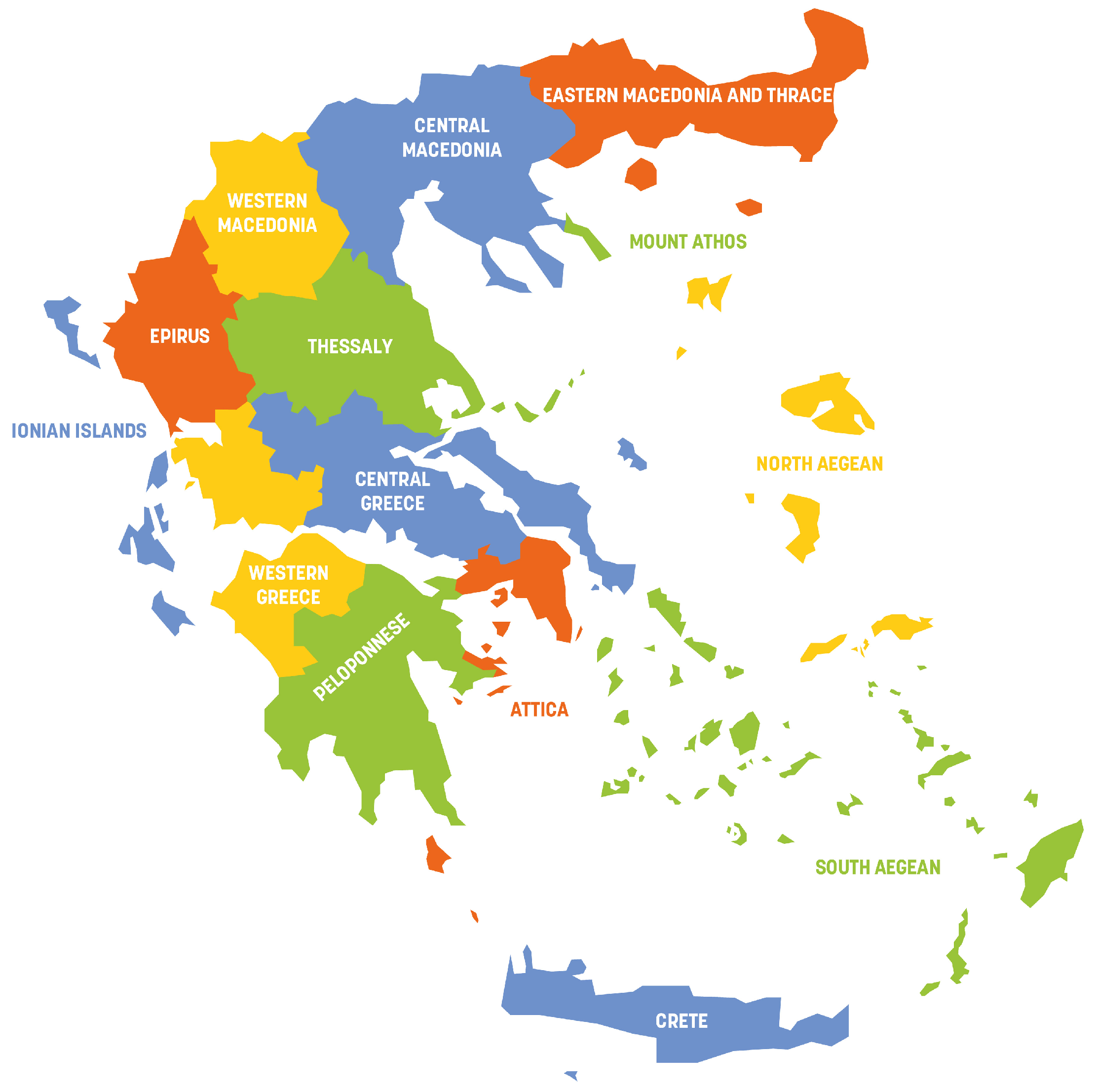

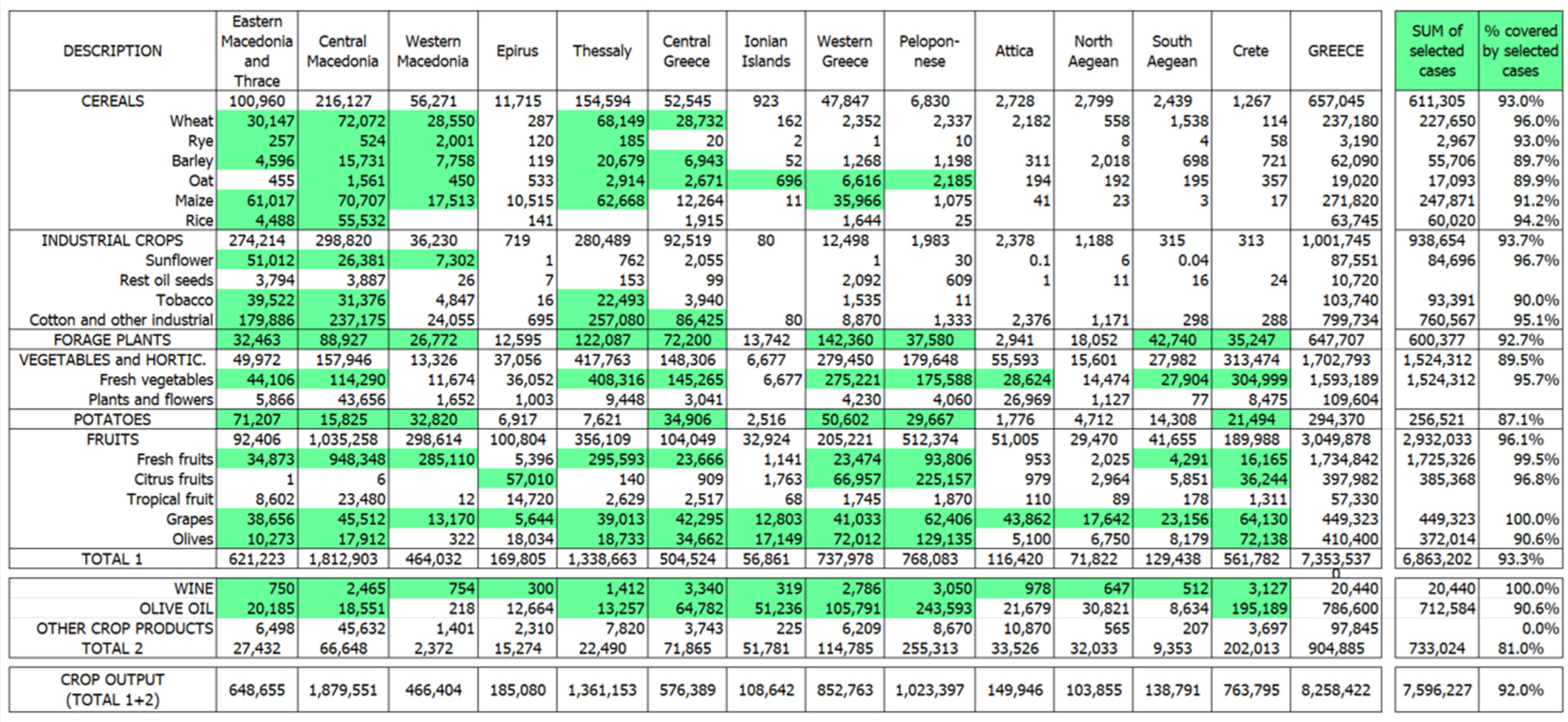
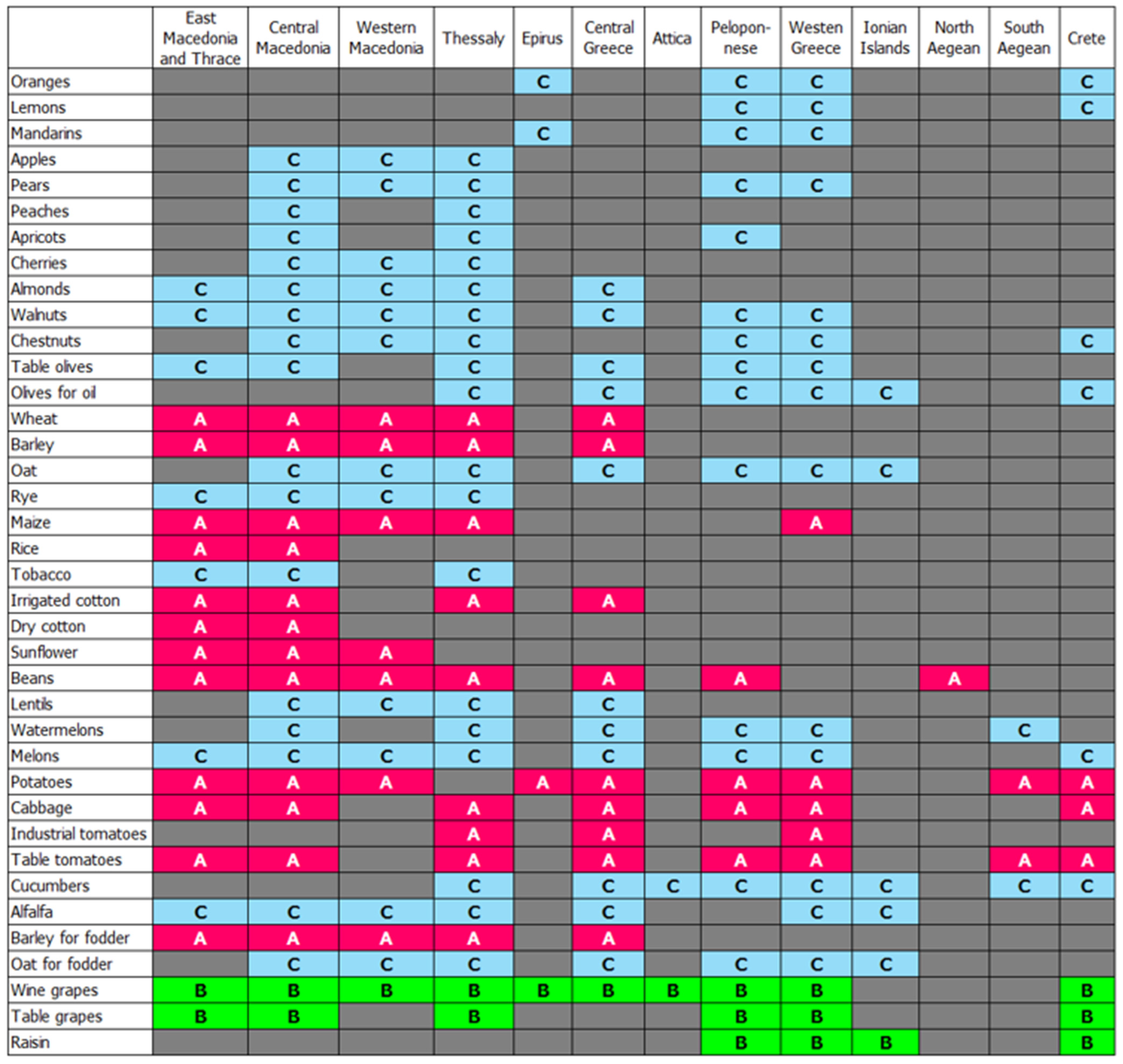

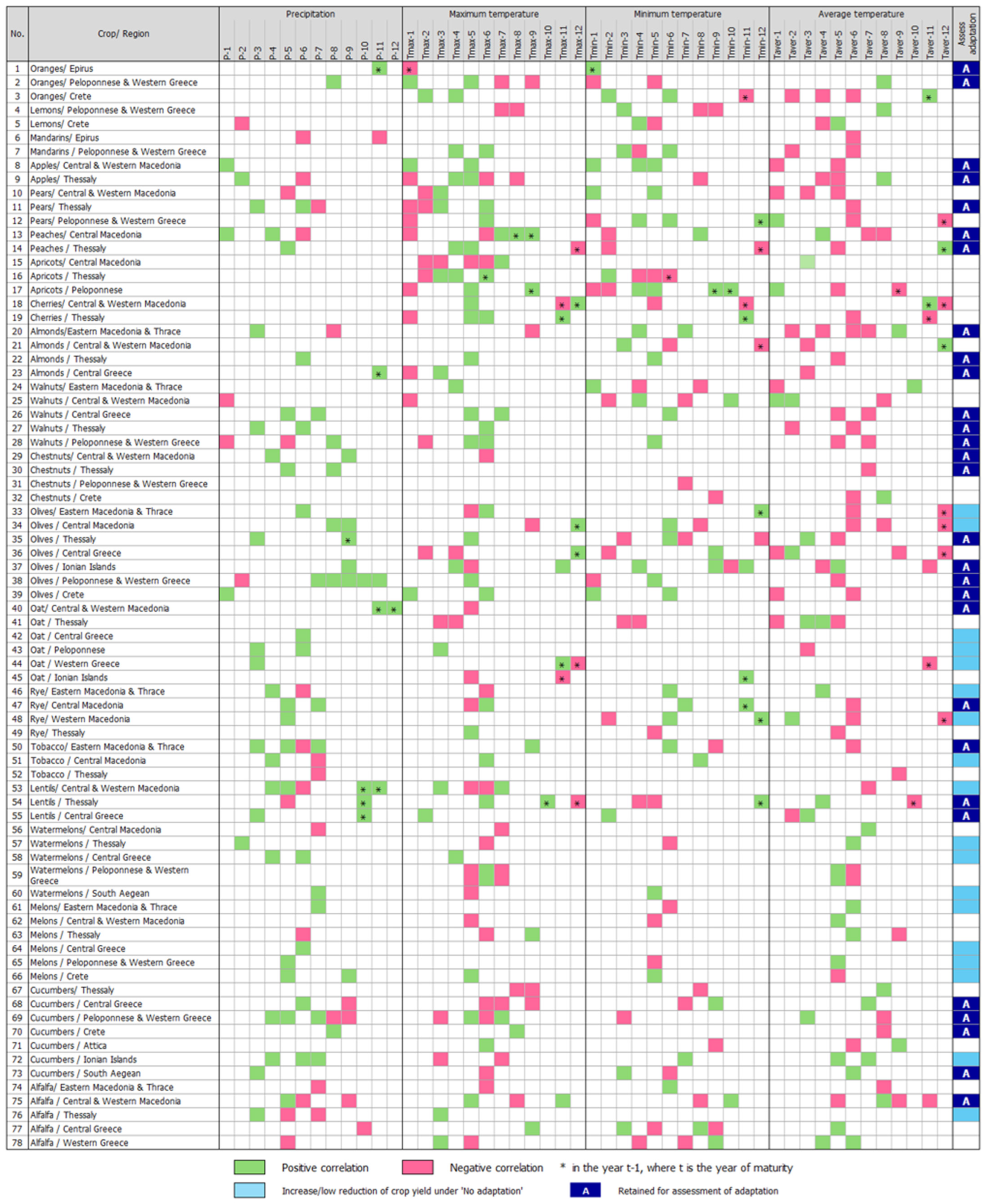
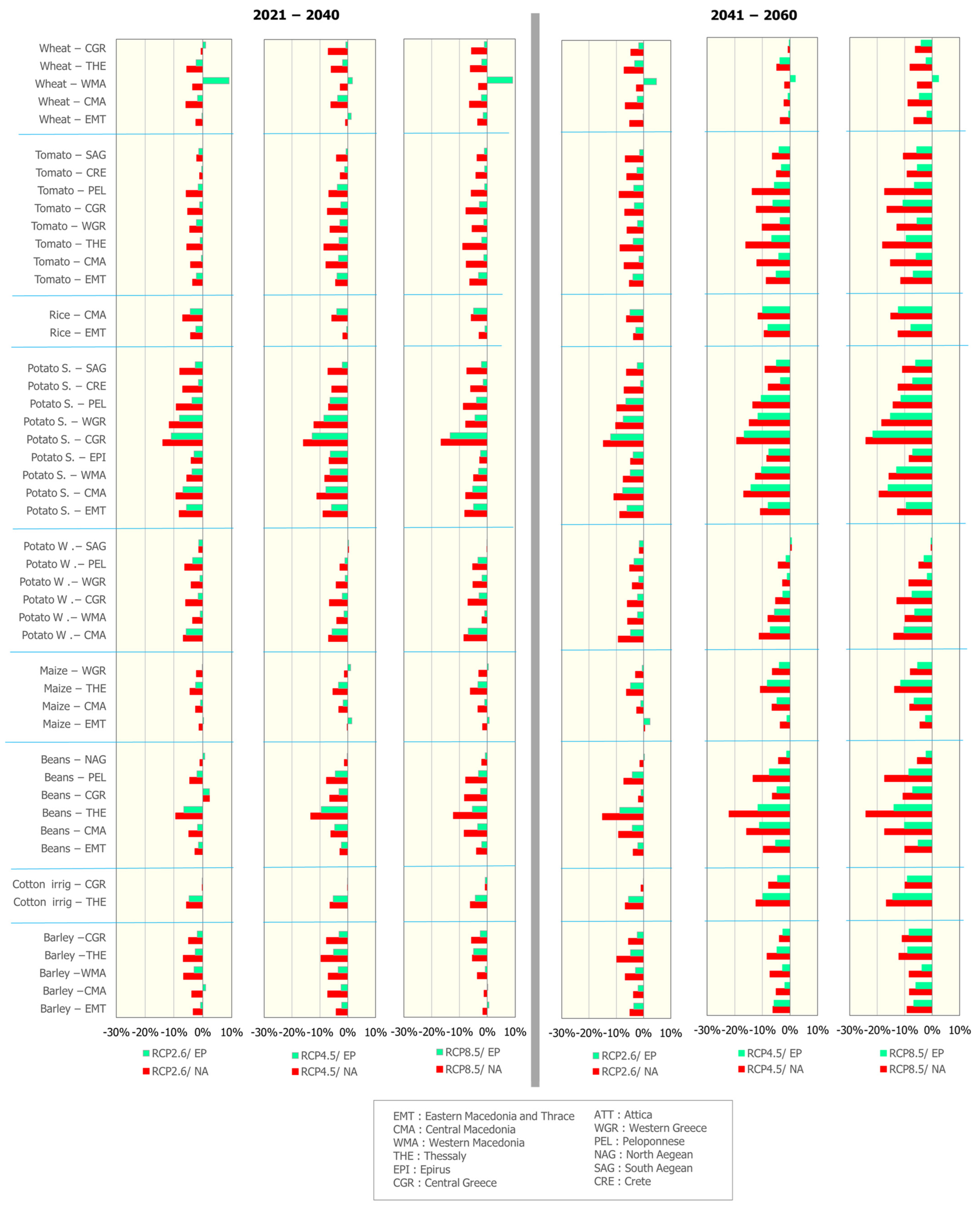
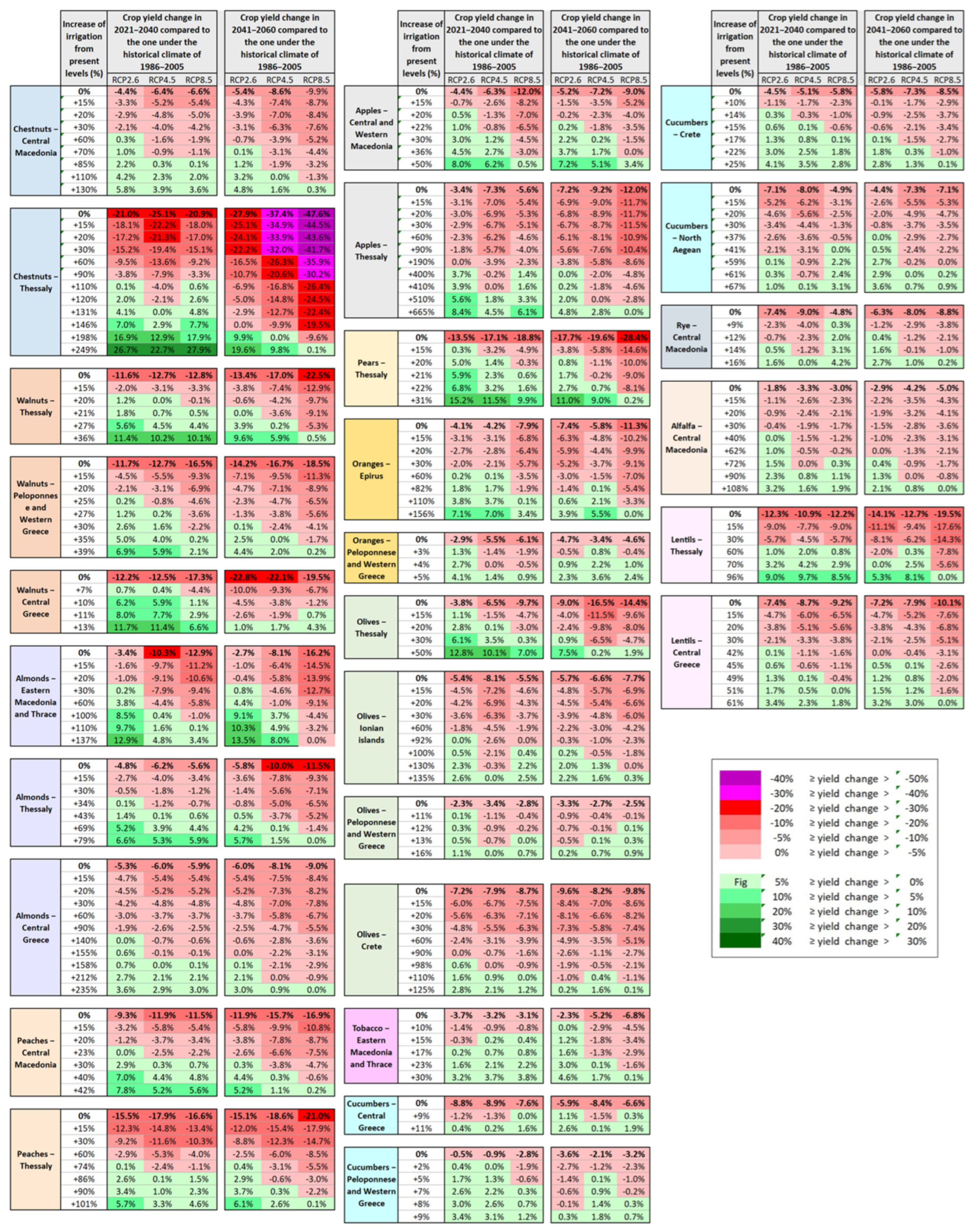
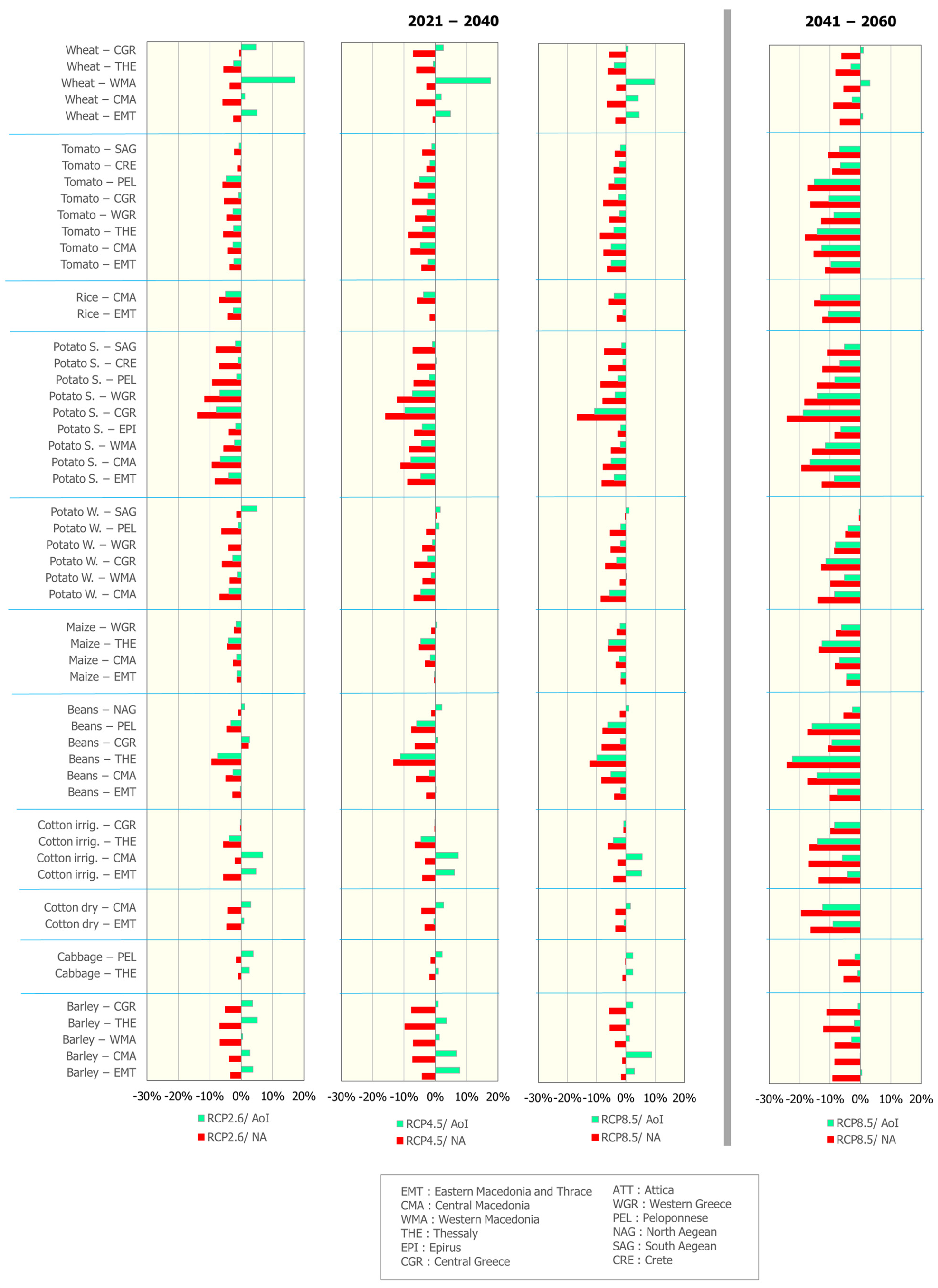
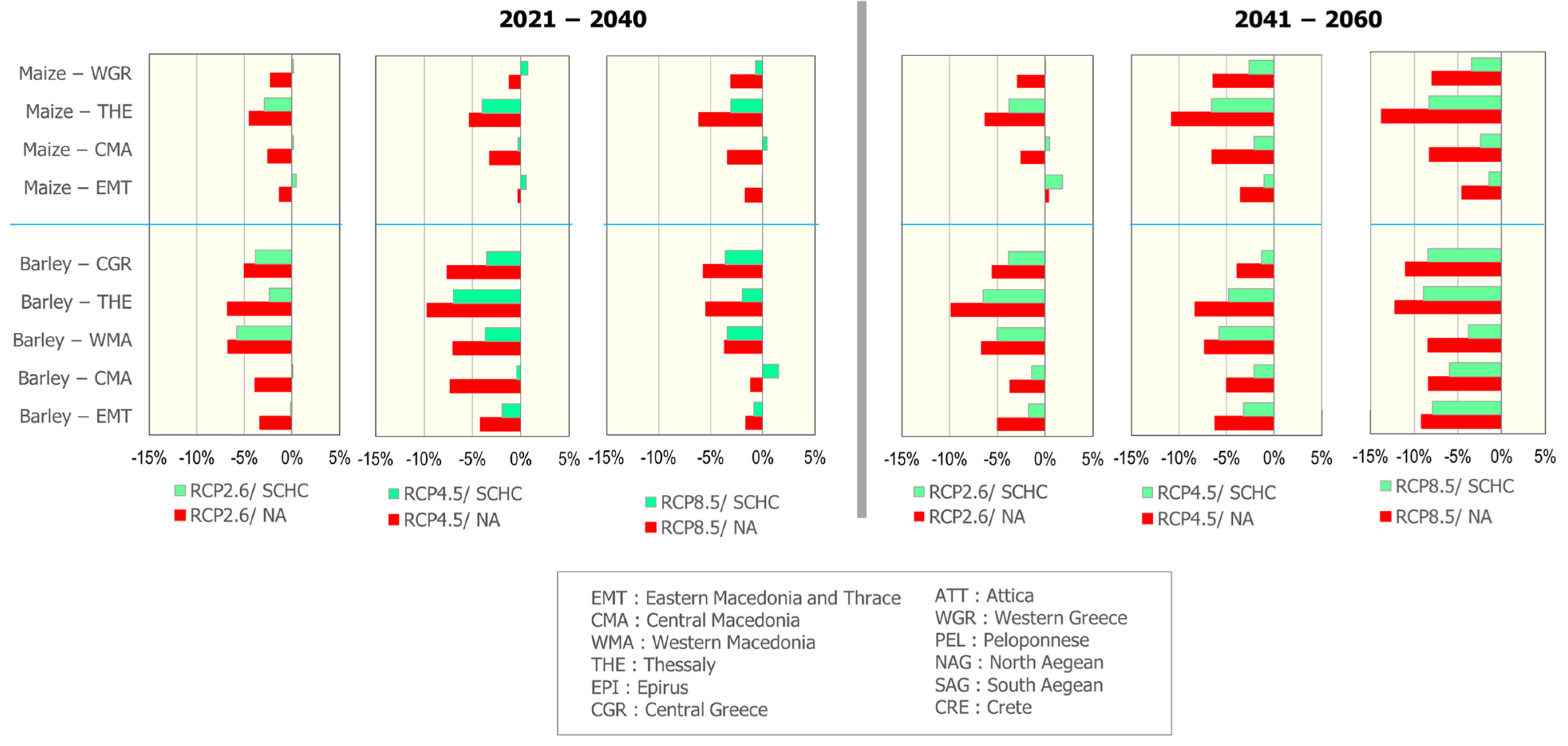
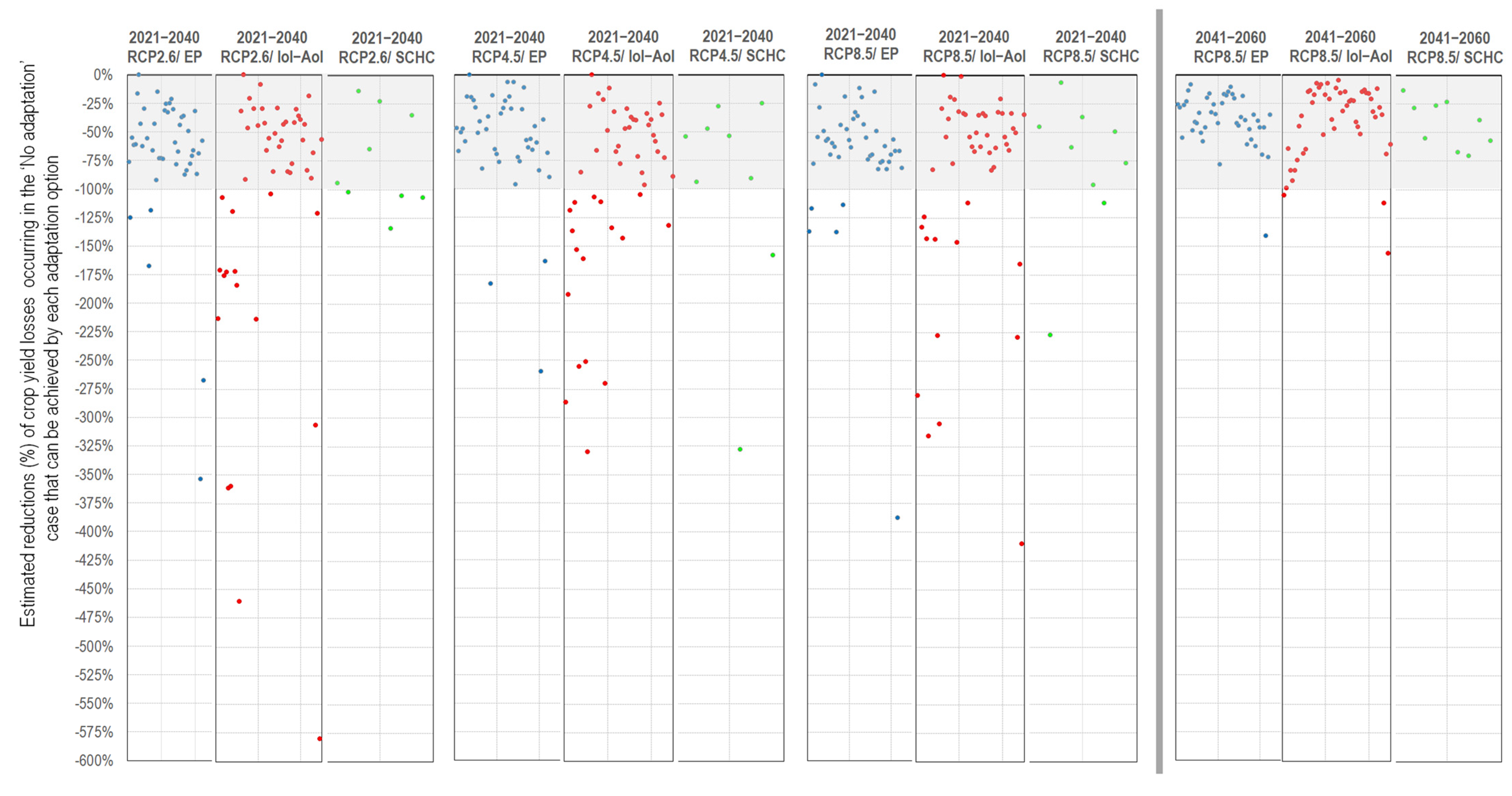
| Regional Climate Models (RCMs) 1 | Global Climate Models (GCMs) | ||
|---|---|---|---|
| ICHEC-EC-EARTH | MOHC-HadGEM2-ES | MPI-M-MPI-ESM-LR | |
| KNMI-RACMO22E | ☑ | ☑ | |
| SMHI-RCA4 | ☑ | ☑ | |
| DMI-HIRHAM5 | ☑ | ||
Disclaimer/Publisher’s Note: The statements, opinions and data contained in all publications are solely those of the individual author(s) and contributor(s) and not of MDPI and/or the editor(s). MDPI and/or the editor(s) disclaim responsibility for any injury to people or property resulting from any ideas, methods, instructions or products referred to in the content. |
© 2024 by the authors. Licensee MDPI, Basel, Switzerland. This article is an open access article distributed under the terms and conditions of the Creative Commons Attribution (CC BY) license (https://creativecommons.org/licenses/by/4.0/).
Share and Cite
Georgopoulou, E.; Gakis, N.; Voloudakis, D.; Daskalakis, M.; Sarafidis, Y.; Lalas, D.P.; Mirasgedis, S. Effectiveness of Options for the Adaptation of Crop Farming to Climate Change in a Country of the European South. Agriculture 2024, 14, 1814. https://doi.org/10.3390/agriculture14101814
Georgopoulou E, Gakis N, Voloudakis D, Daskalakis M, Sarafidis Y, Lalas DP, Mirasgedis S. Effectiveness of Options for the Adaptation of Crop Farming to Climate Change in a Country of the European South. Agriculture. 2024; 14(10):1814. https://doi.org/10.3390/agriculture14101814
Chicago/Turabian StyleGeorgopoulou, Elena, Nikos Gakis, Dimitris Voloudakis, Markos Daskalakis, Yannis Sarafidis, Dimitris P. Lalas, and Sevastianos Mirasgedis. 2024. "Effectiveness of Options for the Adaptation of Crop Farming to Climate Change in a Country of the European South" Agriculture 14, no. 10: 1814. https://doi.org/10.3390/agriculture14101814
APA StyleGeorgopoulou, E., Gakis, N., Voloudakis, D., Daskalakis, M., Sarafidis, Y., Lalas, D. P., & Mirasgedis, S. (2024). Effectiveness of Options for the Adaptation of Crop Farming to Climate Change in a Country of the European South. Agriculture, 14(10), 1814. https://doi.org/10.3390/agriculture14101814







